The 30 Best Elementary Schools in Michigan: Rankings and Academic Performance

Michigan’s elementary education landscape features numerous high-performing schools that consistently deliver exceptional academic outcomes for students.
Parents seeking quality elementary education options will find schools across the state that excel in areas ranging from traditional academics to specialized STEM programs and gifted education.
This comprehensive ranking identifies the top 30 elementary schools in Michigan based on academic performance, student achievement data, and educational quality indicators.
The selected schools represent diverse communities from Detroit and Grand Rapids to suburban districts in Oakland County and Ann Arbor, showcasing excellence across different geographic regions and educational approaches throughout the state.
Here are the 30 best elementary schools in Michigan:
30. Richard C. Hedke Elementary School

Richard C. Hedke Elementary School in Trenton, Michigan serves students in pre-kindergarten through grade 5. The school has about 537 students and approximately 34 full-time teachers, yielding a student-teacher ratio around 16 to 1.
Roughly 40-42% of students qualify for free or reduced-price lunch, reflecting a significant proportion from lower income households. The student body is predominantly White, with about three‐quarters identifying as White, and the remainder being Hispanic, Black, multiracial, or Asian.
On state assessments, about 43-45% of students meet proficiency in math and about 47% in reading. These outcomes place the school around or slightly above state averages in some areas, though there remain gaps to close.
Hedke has earned a grade of B in comprehensive public school rankings and is considered above average within its district. The school offers extracurricular and enrichment opportunities, and operates within a suburban setting.
29. Greenhills School

Greenhills School in Ann Arbor, Michigan, is a private, independent college-preparatory school serving grades 6 through 12. It enrolls around 700 students, with an average class size of 16 and a student-teacher ratio of about 9 to 1.
The school is known for its diverse student body, with nearly half identifying as students of color, and fosters an inclusive environment where individuality is valued.
Academically, Greenhills has a strong reputation, with students achieving high average SAT and ACT scores and a 100 percent graduation rate. Tuition is in the low thirty-thousand-dollar range annually, with financial aid options available.
Beyond the classroom, students can participate in a wide range of extracurricular activities, including athletics, arts, and clubs, encouraging leadership and personal growth.
Greenhills emphasizes close student-faculty relationships, rigorous preparation for college, and the development of well-rounded, engaged young adults.
28. Hoover Elementary School, Livonia

Hoover Elementary School, located in Livonia, Michigan, is a vibrant public school serving students in kindergarten through fourth grade as part of the Livonia Public Schools district.
Known for its warm and inclusive atmosphere, Hoover provides a strong academic foundation while focusing on the whole child.
The school emphasizes excellence in core subjects like reading, math, science, and writing, alongside social-emotional development and positive behavior reinforcement.
With a dedicated teaching staff, small class sizes, and strong family involvement, Hoover creates a nurturing environment where students feel safe, supported, and empowered to succeed.
The school also offers enrichment opportunities, including music, art, and physical education, to encourage creativity and active learning.
Parents praise Hoover’s caring educators, strong leadership, and welcoming community. It remains a top choice for families seeking a high-quality, student-centered education in the Livonia area.
27. Brewster Elementary School, Rochester
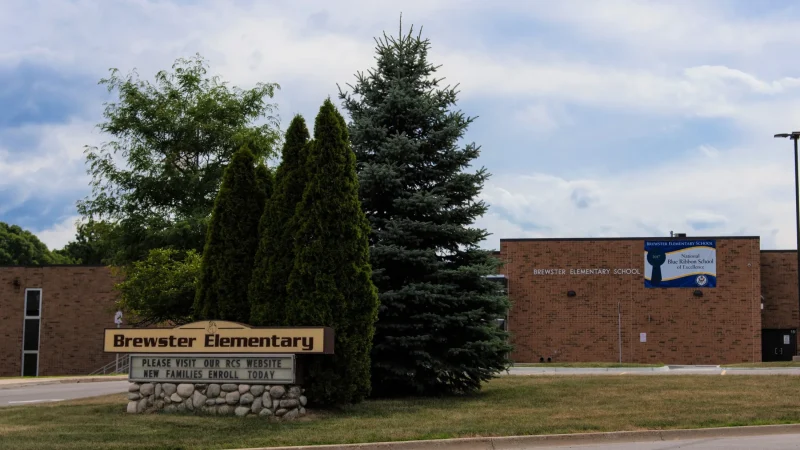
Brewster Elementary School in Rochester Hills, Michigan is a public school serving pre-kindergarten through fifth grade under Rochester Community Schools. The school enrolls about 399 students and employs around 24 full-time teachers, yielding a student-teacher ratio of about 16 to 1.
Its student body is predominantly White (around 69%), with Asian students making up about 17%, Hispanic approximately 6-7%, and smaller percentages of Black and multiracial students.
About 7% of students are eligible for free or reduced-price lunch. Academic performance is strong: nearly 77% of students score at or above proficiency in both math and reading, exceeding many district and state averages.
Brewster is known for consistent performance, low absenteeism, and a stable learning environment. The school is not designated as Title I, and it is seen by many as one of the higher performing elementary schools in its district.
26. East Middle School Elementary Program, Troy
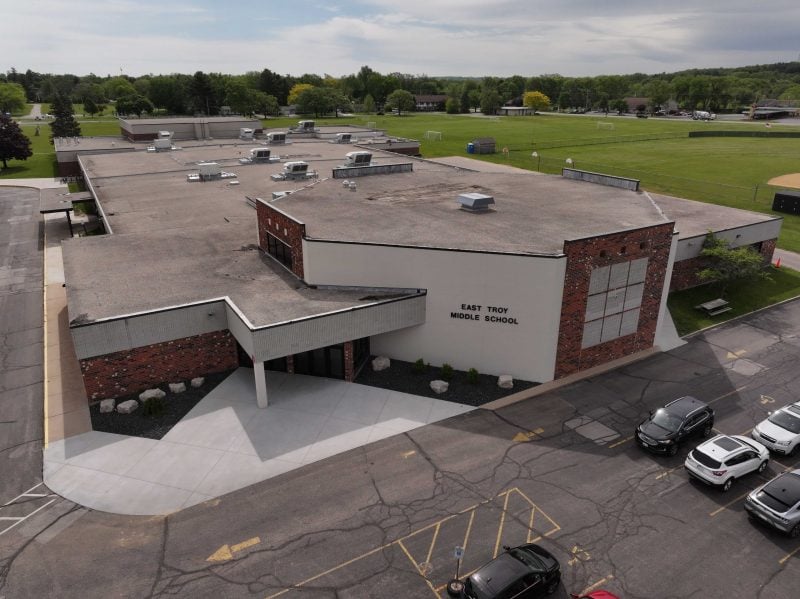
East Middle School Elementary Program operates within the Troy School District, serving students in one of Michigan’s most academically recognized districts. The program benefits from Troy’s strong educational infrastructure and community support.
Troy School District maintains 16 elementary schools total, creating a robust network of educational options. The district consistently ranks among Michigan’s top performing school systems.
Students in this program access quality instructional resources and experienced teaching staff. The school follows Michigan state curriculum standards while incorporating district-specific enhancements.
The program serves families in Troy’s eastern region, providing convenient access to quality elementary education. Class sizes remain manageable to support individual student attention.
Troy’s commitment to educational excellence extends throughout all its elementary programs. The district’s reputation attracts families seeking strong academic foundations for their children.
25. Faxon Academy, Southfield

Faxon Academy in Southfield, Michigan is a tuition-free public charter school serving students from kindergarten through eighth grade. The school is located at 26275 Northwestern Highway in Southfield, on the campus of Hope United Methodist Church.
It is chartered through GPS Solutions and overseen by Saginaw Valley State University. Enrollment is small, with about 126 students in total and a student-teacher ratio near 15 to 1, supported by roughly 8.4 full-time equivalent teachers.
The student population is overwhelmingly African-American, with nearly 91 percent identifying as such, and roughly three-quarters qualify for free or discounted lunch.
Faxon Academy emphasizes a globally-theme curriculum: state standards guide instruction in language arts, mathematics, science, and social studies, along with physical education, under a “Global Mindset” framework.
The school works to develop cultural awareness, bilingual communication, and the social-emotional skills necessary for leadership in an interconnected world.
24. Oakland Elementary School, Royal Oak
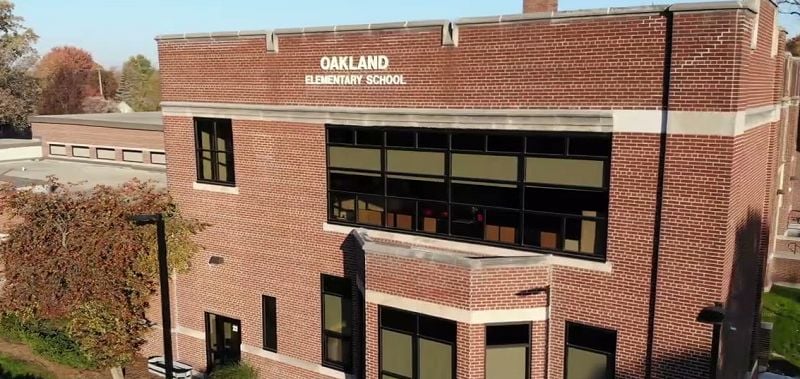
Oakland Elementary School serves students in kindergarten through fifth grade in the Royal Oak Schools district. The school operates within a large suburban setting that provides students with diverse educational opportunities.
The Royal Oak Schools district consists of six elementary schools total. The district maintains a reputation for strong academic performance across its schools.
Oakland focuses on foundational learning for young students. The school emphasizes core subjects including reading, mathematics, science, and social studies.
The school benefits from being part of a well-regarded district that consistently ranks among Michigan’s top performing school systems. Parents in the Royal Oak area have multiple elementary school options within the district.
Oakland Elementary provides a structured learning environment designed to support student growth. The school serves families in the Royal Oak community with educational programs tailored to elementary-age learners.
23. Northwood Elementary School, Oakland County
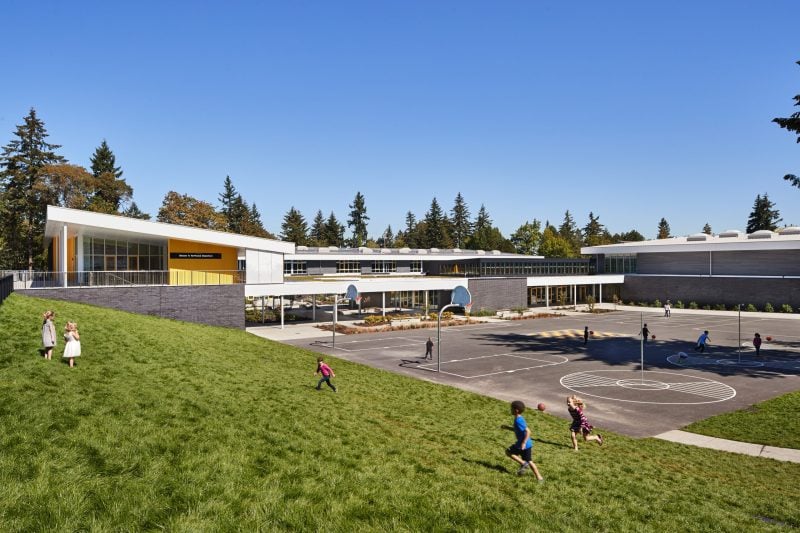
Northwood Elementary School, located in Royal Oak, Michigan, is a well-respected public school serving students from kindergarten through fifth grade.
Part of the Royal Oak Schools district, Northwood is known for its strong academics, supportive teachers, and inclusive community atmosphere.
The school focuses on building a solid foundation in reading, math, science, and social studies while also promoting creativity, collaboration, and problem-solving skills.
Northwood emphasizes social-emotional learning and character development, creating a safe and respectful environment where all students can thrive.
With a variety of enrichment programs, extracurricular activities, and strong parent involvement, Northwood fosters a well-rounded educational experience. Families appreciate the school’s welcoming culture, dedicated staff, and commitment to student success.
Northwood Elementary stands out as a top choice for families in the Royal Oak area seeking both academic excellence and a nurturing school community.
22. Bemis Elementary, Troy
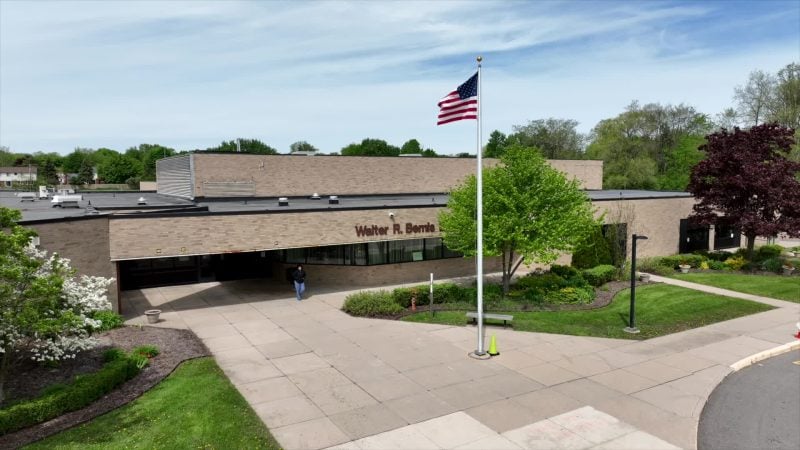
Bemis Elementary School in Troy, Michigan, is a public school serving Kindergarten through fifth grade. It enrolls about 450 students and operates with roughly 26 full-time teachers, giving it a student-teacher ratio of approximately 17 to 1.
Students come from a diverse range of backgrounds: over half identify as Asian, nearly a third as White, and smaller percentages as multiracial, Black, or Hispanic. About 8.6 percent qualify for free or reduced-price lunch.
Bemis often ranks among the top elementary schools in Michigan. Attendance and test scores are strong, with around 85 percent of students proficient in both reading and math, well above state averages.
The school spends about $14,775 per pupil. Its address is 3571 Northfield Parkway, in the Troy School District. Bemis is known for its rigorous academic programs, committed teaching staff, and supportive learning environment.
21. Conant Elementary, Bloomfield Township

Conant Elementary School in Bloomfield Hills, Michigan is a public school serving pre-kindergarten through grade 5. It has an enrollment of around 500 students and a student-teacher ratio of about 14 to 1.
The student body is predominantly White (approximately three-quarters), with smaller percentages of Asian, Black, Hispanic, and multiracial students. Approximately 6 percent of students are eligible for free or reduced-price lunch.
Academically, about 77 percent of students meet proficiency in math and around 82 percent in reading, figures that are notably higher than many state averages.
Conant offers the International Baccalaureate Primary Years Programme with an inquiry-based, integrated curriculum.
The school emphasizes the development of the whole child, fostering critical thinking, global awareness, and community-oriented values. It is known for its strong academic performance, caring faculty, and a supportive learning environment in a suburban setting.
20. Wass Elementary School, Troy
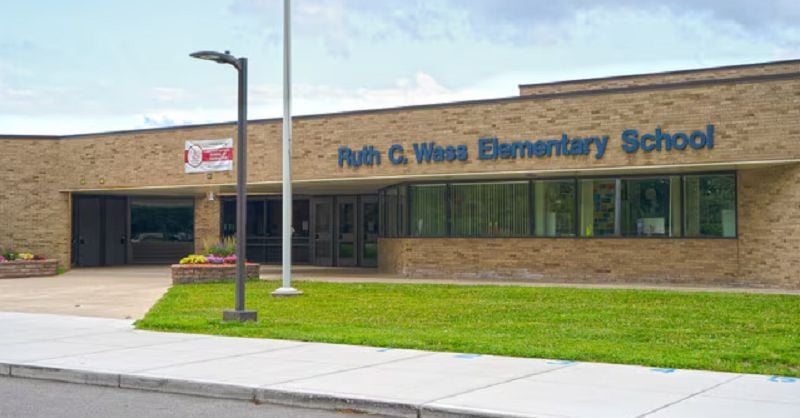
Wass Elementary School, located in Troy, Michigan, is a highly regarded public school within the Troy School District, known for its academic excellence and supportive learning environment.
Serving students in kindergarten through fifth grade, Wass emphasizes strong foundational skills in reading, math, science, and social studies, while also promoting creativity, critical thinking, and social-emotional growth.
The school is consistently recognized for high student achievement and offers enrichment programs, student leadership opportunities, and a strong focus on character education.
With a dedicated staff, engaged families, and a welcoming atmosphere, Wass fosters a close-knit community where every child is encouraged to reach their full potential.
Parents praise the school’s strong communication, caring teachers, and inclusive culture.
Wass Elementary stands out as one of the top elementary schools in the region, providing a nurturing and academically challenging environment for young learners in Troy.
19. Hampton Elementary, Farmington Hills
Hampton Elementary serves students in Farmington Hills as part of the Farmington Public School District. The district ranks 138 out of 613 school districts in Michigan and holds a 4-star rating.
The school operates within a well-regarded district system that manages 7 elementary schools throughout Farmington Hills. This provides families with multiple educational options in the area.
Farmington Public School District maintains consistent academic standards across its elementary schools. The district’s strong reputation reflects its commitment to quality education and student achievement.
Hampton Elementary benefits from being part of a district that ranks in the top tier of Michigan school systems. The school serves its local community while maintaining the educational standards expected from the highly-rated district.
Students at Hampton Elementary receive instruction that aligns with district-wide curriculum goals and educational objectives.
18. Mack School, Ann Arbor
Mack School, officially known as Eberwhite-Mack Elementary, is a small and historic public school located in Ann Arbor, Michigan.
Part of the Ann Arbor Public Schools district, Mack has a long-standing reputation for academic excellence, community involvement, and nurturing student development.
The school serves students in grades K–5 and offers a warm, inclusive environment where children receive personalized attention and support.
With a strong emphasis on literacy, math, science, and social-emotional learning, Mack helps students build a solid foundation for future academic success.
The school also values creativity and the arts, providing enrichment through music, visual arts, and physical education. Parents appreciate Mack’s dedicated teachers, close-knit atmosphere, and emphasis on whole-child development.
Located near the University of Michigan, Mack School benefits from a culturally rich and engaged community, making it a beloved neighborhood school in Ann Arbor.
17. Emerald Elementary School, Troy
Emerald Elementary School operates as part of the Troy School District in Michigan. The school serves students in the elementary grades within one of the state’s higher-performing districts.
Troy School District ranks 43rd out of 613 districts statewide and holds a 5-star rating. This district-wide performance reflects the quality of education students receive at Emerald Elementary.
The school benefits from being located in Troy, which houses 16 elementary schools total. Most of these schools fall under the Troy School District umbrella, creating a competitive academic environment.
Troy’s elementary schools consistently demonstrate strong academic outcomes. The district’s reputation attracts families seeking quality public education for their children.
Emerald Elementary contributes to the district’s overall success through its commitment to student achievement and educational excellence.
16. North Star Academy, Detroit
North Star Academy operates as part of the Detroit public school system. The school serves elementary-age students in the city’s educational landscape.
The academy focuses on providing foundational education to its student population. Like many Detroit elementary schools, it works within the broader district framework to deliver curriculum and programming.
North Star Academy is among the elementary school options available to families in Detroit. The school participates in district-wide initiatives and follows state educational standards for Michigan elementary schools.
Parents considering North Star Academy can evaluate it alongside other Detroit elementary schools. The school’s performance and offerings can be compared with neighboring institutions in the district.
The academy represents one of the educational choices within Detroit’s diverse elementary school system. It serves the local community as part of the city’s public education infrastructure.
15. North Canton Elementary, Canton
North Canton Elementary serves students in Canton, Michigan as part of the local public school system. The school provides educational services to elementary-age children in the community.
Canton’s elementary schools consistently demonstrate strong academic performance. Students receive instruction in core subjects including mathematics, English language arts, science, and social studies.
The school maintains a focus on supporting student achievement through various educational programs. Teachers work to create learning environments that promote both academic growth and personal development.
North Canton Elementary benefits from Canton’s commitment to public education. The district allocates resources to ensure students have access to quality instructional materials and learning opportunities.
Families in the Canton area can access information about enrollment procedures and school policies through the district’s administrative offices. The school serves as an important educational institution within the broader Canton community.
14. West Shore Elementary, Detroit
West Shore Elementary operates within the West Shore Educational Service District in the Detroit area. The school serves students in the elementary grades and maintains its position among the district’s educational institutions.
The school focuses on providing foundational academic instruction across core subject areas. Teachers work to develop students’ skills in reading, mathematics, science, and social studies through structured curriculum programs.
West Shore Elementary emphasizes creating a supportive learning environment for its student population. The school maintains appropriate student-teacher ratios to facilitate individualized attention and academic progress.
The institution participates in district-wide educational initiatives and assessment programs. Parents can access information about the school’s performance metrics and educational offerings through district resources.
West Shore Elementary continues to serve families in the Detroit community as part of the broader educational landscape in the region.
13. Farnsworth Elementary, Rochester Hills
Farnsworth Elementary School serves students in Rochester Hills through the Rochester Community School District. The school provides education for elementary-aged children in this affluent suburban community.
Located in one of Michigan’s well-regarded school districts, Farnsworth Elementary benefits from strong community support and resources. The Rochester Community School District consistently ranks among the top performing districts in the state.
The school focuses on providing a comprehensive elementary education with emphasis on core academic subjects. Students receive instruction in reading, mathematics, science, and social studies through structured curriculum programs.
Farnsworth Elementary maintains smaller class sizes that allow for more individualized attention. Teachers work to create a supportive learning environment that helps students develop foundational academic skills.
The school serves families in the Rochester Hills area who value educational excellence. Parents often choose this school for its reputation within the highly-rated Rochester Community School District system.
12. Northeastern Elementary School, Bloomfield Hills
Northeastern Elementary School operates within the highly-rated Bloomfield Hills School District. The district consistently ranks among Michigan’s top-performing school systems.
Bloomfield Hills elementary schools maintain an average ranking of 10/10 statewide. This places them in the top 1% of Michigan public elementary schools.
The school serves a diverse student population with 26% minority enrollment. The majority of minority students are Black and Asian backgrounds.
Northeastern Elementary benefits from the district’s strong academic reputation and resources. Bloomfield Hills Schools ranks better than 97.1% of districts across Michigan.
The school provides students with access to exceptional educational programs and facilities. Parents choose Northeastern Elementary for its commitment to academic excellence and supportive learning environment.
Students at Northeastern Elementary receive instruction from qualified teachers within a well-funded district. The school maintains the high standards expected throughout Bloomfield Hills Schools.
11. Pierce Elementary School, Grosse Pointe
Pierce Elementary School serves students in the Grosse Pointe Public School System. The school operates within a district that ranks better than 93.3% of districts in Michigan.
Elementary schools in Grosse Pointe maintain an average ranking of 9/10. This places them in the top 20% of Michigan public elementary schools.
The Grosse Pointe Public School System includes several elementary schools alongside Pierce. These schools consistently deliver strong academic performance across the district.
Students at Pierce benefit from the district’s commitment to educational excellence. The school serves families in the Grosse Pointe area with established academic programs.
The district’s minority enrollment stands at 32% of the student body. This figure is slightly below the Michigan public elementary school average of 38%.
Pierce Elementary operates as part of a comprehensive school system that includes multiple elementary, middle, and high schools throughout the Grosse Pointe community.
10. Harrison Elementary School, Plymouth
Harrison Elementary School operates within the Plymouth-Canton Community Schools district in Michigan. The school serves students in the early elementary grades with a focus on foundational academic skills.
The Plymouth-Canton Community Schools district ranks better than 83.6% of districts statewide in Michigan. This ranking reflects the district’s commitment to educational excellence across all its elementary schools.
Students at Harrison Elementary follow the Michigan Academic Standards curriculum. The school provides a structured learning environment that emphasizes core subjects including mathematics, reading, and science.
The district’s elementary schools benefit from established educational programs and resources. Harrison Elementary maintains small class sizes to support individualized attention for each student.
Located in Plymouth, the school serves families in the surrounding community. Parents choose Harrison Elementary for its stable educational foundation and connection to the highly-rated district system.
9. Burns Elementary School, Grand Rapids
Burns Elementary School serves students in the Grand Rapids Public Schools district. The school operates as part of Michigan’s second-largest school district.
Located in Grand Rapids, Burns Elementary provides educational programs for elementary-age students. The school follows Michigan state curriculum standards and district guidelines.
Grand Rapids Public Schools has faced challenges in recent years with district-wide performance rankings. The district serves a diverse student population across multiple elementary schools.
Burns Elementary maintains standard elementary school operations including classroom instruction and student support services. The school participates in district-wide initiatives and programs.
Parents considering Burns Elementary can access school information through the Grand Rapids Public Schools website. The district provides enrollment details and academic program information for families.
The school operates within the broader Grand Rapids educational landscape alongside other elementary options in the area.
8. Lakeside Elementary, Ann Arbor
Lakeside Elementary operates within the highly-rated Ann Arbor Public Schools district. The district ranks 71 out of 613 districts statewide and maintains a 4 out of 5 star rating.
Ann Arbor Public Schools serves students through 21 elementary schools. These schools accommodate grades K-5 or K-8 with enrollment ranging from 222 to 599 students per building.
The district consistently produces strong academic outcomes across its elementary programs. Schools within Ann Arbor Public Schools benefit from comprehensive educational resources and community support.
Lakeside Elementary contributes to the district’s reputation for quality elementary education. The school operates within a system known for maintaining high academic standards throughout southeastern Michigan.
Students at Lakeside Elementary access the same district-wide programs and services available across Ann Arbor Public Schools. This includes specialized programming and support services designed to meet diverse student needs.
7. West Hills STEM Academy
West Hills STEM Academy operates as a public K-8 school located in Bremerton, Washington. The academy serves as part of the Bremerton School District system.
The school focuses on project-based STEM learning approaches. Students engage with science, technology, engineering, and mathematics through hands-on educational experiences.
West Hills STEM Academy recently completed a 14,000 square foot addition to enhance its facilities. The new construction incorporates energy-saving features and natural ventilation systems.
The academy maintains a student population with 72.6% receiving free and reduced lunch assistance. This percentage exceeds the Washington state average of 51.2%.
The school operates under Bremerton School District’s non-discrimination policies. These policies cover various protected categories including race, gender, disability status, and veteran status.
West Hills STEM Academy represents one of 13 schools within the Bremerton School District network.
6. Rogers Elementary School, Birmingham
Rogers Elementary School serves students in Birmingham, Michigan, within one of the state’s highly regarded school districts. The school maintains strong academic standards consistent with Birmingham’s reputation for educational excellence.
Birmingham elementary schools collectively demonstrate impressive performance metrics. The district’s elementary schools average high rankings compared to other Michigan public schools.
The school benefits from Birmingham’s commitment to quality education and community support. Families choose Rogers Elementary for its dedicated teaching staff and comprehensive curriculum offerings.
Located in the Birmingham area, the school serves a diverse student population. The facility provides modern learning environments designed to support elementary-aged children’s developmental needs.
Rogers Elementary emphasizes both academic achievement and character development. Students participate in various educational programs that prepare them for future academic success in middle and high school settings.
5. Webster Elementary School, Livonia
Webster Elementary School stands as Michigan’s top-ranked elementary institution. This public magnet school serves 272 students across grades 1-6 in Livonia.
The school operates as part of the Livonia Public Schools District. It maintains a student-to-teacher ratio of 16.8 students per educator.
Webster functions as a specialized magnet school with a Gifted & Talented program. This focus attracts high-achieving students from across the district.
The school consistently ranks within the top 1% of all public elementary schools statewide. Its academic performance places it among Michigan’s most distinguished educational institutions.
Parents and education professionals recognize Webster for its rigorous academic standards. The school’s magnet status allows it to offer specialized programming beyond traditional elementary curricula.
4. Webb Elementary School, Troy
Webb Elementary School operates within the Troy School District in Troy, Michigan. The school serves students in the elementary grades as part of one of Michigan’s top-performing school districts.
Troy School District ranks better than 93% of districts statewide. The district jumped six positions in recent statewide rankings, demonstrating consistent improvement in educational quality.
Webb Elementary benefits from the district’s strong academic programs and resources. Troy maintains 16 elementary schools that consistently perform at high levels across standardized assessments.
The school operates in Troy, a city known for its commitment to educational excellence. Troy School District schools regularly appear on top performer lists for Michigan elementary schools.
Students at Webb Elementary have access to comprehensive educational programs. The school maintains the district’s reputation for preparing students for continued academic success in middle and high school levels.
3. Crestwood Accelerated Program
Crestwood Accelerated Program stands as one of Michigan’s top-performing elementary schools. Located in Dearborn Heights, this public magnet school serves students in kindergarten through fourth grade.
The school operates as a gifted and talented program within the Crestwood School District. With only 30 students enrolled, it maintains an intimate learning environment with a 15-to-1 student-teacher ratio.
Academic performance places Crestwood Accelerated Program in the top 1% of all Michigan public schools. Both math and reading proficiency scores rank in the state’s top 1% based on recent test data.
The program focuses on accelerated learning for high-achieving students. Small class sizes allow for individualized attention and advanced curriculum delivery.
This specialized elementary school demonstrates consistent excellence in student outcomes. The combination of selective enrollment and dedicated resources creates an environment where academically gifted students can thrive.
2. Avondale Gifted And Talented Education
Avondale Gifted And Talented Education ranks within the top 1% of all public schools in Michigan. The school serves 328 students in grades 2-8 in Rochester Hills.
This magnet school focuses specifically on gifted and talented education programs. It maintains a student-to-teacher ratio of 16.5 to 1, providing personalized attention for advanced learners.
The school has earned recognition as one of Michigan’s top ten public schools for two consecutive years. It consistently appears on lists of the best public elementary schools in both Michigan and the Rochester area.
Avondale School District designed this institution to empower gifted, advanced, and high-achieving students. The school provides specialized pathways that help students reach their highest potential through targeted programming.
The campus operates as part of the broader Avondale School District’s commitment to advanced learning opportunities. Students benefit from curriculum specifically tailored to accelerated academic development.
1. Amerman Elementary School
Amerman Elementary School stands as one of Michigan’s premier educational institutions. Located in Northville, the school consistently ranks within the top 1% of all public schools in the state.
The school serves 554-561 students from kindergarten through fifth grade. It operates as part of the Northville Public Schools district, which includes seven elementary schools total.
Academic performance at Amerman remains exceptional. Between 77-91% of students demonstrate proficiency in English Language Arts. Math proficiency rates range from 82-87%, significantly above state averages.
The school maintains a student-teacher ratio of approximately 18.8 students per teacher. This allows for more individualized attention and support for each student’s learning needs.
Amerman offers specialized programs including Gifted and Talented education opportunities. The school has earned recognition through various awards, including eligibility for the U.S. News Best Elementary Schools badge.
Recent facility improvements are underway through Bond 2023 funding, enhancing the learning environment for students and staff.
Understanding Elementary School Rankings in Michigan
Michigan elementary school rankings rely on multiple assessment metrics including state test performance, teacher qualifications, and school resources. These evaluations incorporate both academic outcomes and environmental factors that contribute to student success.
Key Ranking Criteria
Academic Performance serves as the primary ranking factor for Michigan elementary schools. State test scores from the M-STEP (Michigan Student Test of Educational Progress) assessments measure student proficiency in mathematics, English language arts, science, and social studies.
Student-teacher ratios significantly impact school rankings. Lower ratios typically indicate more individualized attention and better learning outcomes for students.
Teacher quality metrics include educator experience levels, certification status, and advanced degree percentages. Schools with highly qualified teaching staff consistently rank higher in state evaluations.
Student diversity indices measure demographic representation across racial, ethnic, and socioeconomic lines. Schools demonstrating successful outcomes across diverse populations receive recognition in ranking systems.
Parent and community reviews contribute additional perspectives beyond standardized metrics. These evaluations provide insights into school culture, communication effectiveness, and overall satisfaction levels.
Role of State Assessments and Accreditation
M-STEP assessments determine school accountability ratings through the Michigan School Index System. This framework evaluates schools on student achievement, growth, and achievement gaps between demographic groups.
Schools receive ratings of A through F based on their performance across multiple indicators. Top-performing schools typically earn A ratings with consistent high achievement scores.
Federal accountability measures under the Every Student Succeeds Act (ESSA) require schools to meet specific performance benchmarks. Michigan incorporates these federal requirements into state-level school evaluations.
Accreditation status through organizations like AdvancED provides additional credibility markers. Schools maintaining proper accreditation demonstrate compliance with educational standards and continuous improvement practices.
The Michigan Department of Education publishes annual school report cards displaying assessment results, graduation rates, and demographic information for public transparency.
Importance of School Diversity and Resources
Funding levels directly correlate with available resources and educational opportunities. Schools with higher per-pupil expenditures often provide enhanced programming, technology access, and facility maintenance.
Specialized programs including gifted education, special needs services, and enrichment activities distinguish top-performing schools. These offerings demonstrate institutional commitment to serving diverse learning needs.
Technology integration and modern facilities support contemporary learning approaches. Schools investing in updated equipment and infrastructure typically achieve better student engagement and outcomes.
Community partnerships with local businesses, organizations, and higher education institutions expand learning opportunities beyond traditional classroom settings.
Socioeconomic diversity within school populations creates environments where students experience varied perspectives and backgrounds. This exposure prepares students for success in increasingly diverse communities and workplaces.
How Michigan Supports High-Quality Elementary Education
Michigan’s commitment to elementary education excellence stems from three core areas: progressive teaching methodologies that emphasize personalized learning, robust community partnerships that extend learning beyond classroom walls, and comprehensive state-level programs that ensure consistent quality across all districts.
Innovative Teaching Practices
Michigan elementary schools implement project-based learning approaches that connect academic concepts to real-world applications. Students engage in hands-on activities that develop critical thinking skills while meeting state standards.
The state promotes STEAM education integration across grade levels. Elementary programs incorporate science, technology, engineering, arts, and mathematics through collaborative projects and maker spaces.
Differentiated instruction remains a cornerstone of Michigan’s educational framework. Teachers receive training in adaptive teaching methods that accommodate diverse learning styles and abilities within single classrooms.
Technology integration supports personalized learning paths. Districts utilize digital platforms that adjust content difficulty based on individual student progress and comprehension levels.
Professional development programs equip educators with current pedagogical strategies. Michigan provides ongoing training in areas such as:
- Social-emotional learning implementation
- Culturally responsive teaching methods
- Data-driven instruction techniques
- Multi-tiered support systems
Community and Parental Involvement
Michigan schools foster strong parent-school partnerships through structured volunteer programs and regular communication channels. Parents participate in classroom activities, field trips, and educational decision-making processes.
Community organizations collaborate directly with elementary schools to provide enrichment opportunities. Local businesses, libraries, and cultural institutions offer resources that supplement classroom instruction.
Parent Teacher Organizations (PTOs) play active roles in fundraising and program development. These groups support initiatives such as technology upgrades, art programs, and after-school activities that enhance educational experiences.
Family engagement extends beyond traditional boundaries through evening workshops and multilingual communication. Schools provide resources that help parents support learning at home effectively.
Community mentorship programs connect students with local professionals. These relationships provide academic support and expose children to diverse career possibilities within their communities.
Statewide Educational Initiatives
The Michigan Department of Education implements comprehensive quality assurance measures across all elementary schools. Regular assessments and support systems ensure consistent educational standards statewide.
Early literacy initiatives receive substantial state funding and focus. Michigan’s Read by Grade Three law provides intervention services for students who need additional reading support before fourth grade.
State-funded professional learning communities connect educators across districts. Teachers share best practices and collaborate on curriculum development through structured networking opportunities.
Michigan’s school accountability system evaluates multiple performance indicators beyond test scores. Factors include student growth, English learner progress, and school climate measurements.
Resource allocation programs ensure equitable funding distribution to elementary schools. The state provides additional support to districts serving high-need student populations through targeted grants and assistance programs.




